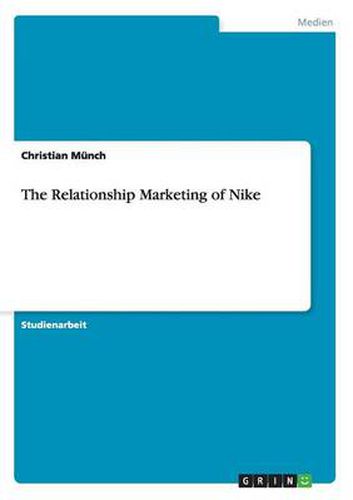Readings Newsletter
Become a Readings Member to make your shopping experience even easier.
Sign in or sign up for free!
You’re not far away from qualifying for FREE standard shipping within Australia
You’ve qualified for FREE standard shipping within Australia
The cart is loading…






Studienarbeit aus dem Jahr 2012 im Fachbereich Medien / Kommunikation - Public Relations, Werbung, Marketing, Social Media, Sheffield Hallam University, Sprache: Deutsch, Abstract: According to Godson (2011), relationship marketing is a marketing approach that is based on networks, interactions and relationships . Morgan and Hunt (1994) propose that relationship marketing includes all marketing activities that aim at establishing, developing and maintaining successful relational exchanges. Gummesson (2008) defines relationship marketing as marketing that is based on interactions within networks of relationships . In line with the previous, Kotler (2011) delineates relationship marketing as having multifarious relationships with marketing partners. Within the last two decades relationship marketing has become a widely accepted marketing paradigm (Finne and Groenroos, 2009) but It is debatable whether relationship marketing is a fundamentally new marketing approach or if it has been part of the traditional marketing theory all along (Payne, 1995). Godson (2011) points out that the main aim of relationship marketing is the development and maintenance of long term relationships with all stakeholders of a business. The most important stakeholder for most businesses is the customer. Against the backdrop of an increasingly competitive business environment, companies are forced to keep their customers loyal, ensure their satisfaction and find out as much as possible about them (Kotler, 2011). Truly loyal customers are less price sensitive, more likely to give referrals and more responsive to promotion & communication campaigns (Godson, 2009). Hence, a company’s profitability and its ability to retain customers are positively linked (Reichheld, 1996). Instead of merely focusing their marketing activities on the acquisition of new customers, companies need to balance between customer retention and acquisition (Godson, 2
$9.00 standard shipping within Australia
FREE standard shipping within Australia for orders over $100.00
Express & International shipping calculated at checkout
Studienarbeit aus dem Jahr 2012 im Fachbereich Medien / Kommunikation - Public Relations, Werbung, Marketing, Social Media, Sheffield Hallam University, Sprache: Deutsch, Abstract: According to Godson (2011), relationship marketing is a marketing approach that is based on networks, interactions and relationships . Morgan and Hunt (1994) propose that relationship marketing includes all marketing activities that aim at establishing, developing and maintaining successful relational exchanges. Gummesson (2008) defines relationship marketing as marketing that is based on interactions within networks of relationships . In line with the previous, Kotler (2011) delineates relationship marketing as having multifarious relationships with marketing partners. Within the last two decades relationship marketing has become a widely accepted marketing paradigm (Finne and Groenroos, 2009) but It is debatable whether relationship marketing is a fundamentally new marketing approach or if it has been part of the traditional marketing theory all along (Payne, 1995). Godson (2011) points out that the main aim of relationship marketing is the development and maintenance of long term relationships with all stakeholders of a business. The most important stakeholder for most businesses is the customer. Against the backdrop of an increasingly competitive business environment, companies are forced to keep their customers loyal, ensure their satisfaction and find out as much as possible about them (Kotler, 2011). Truly loyal customers are less price sensitive, more likely to give referrals and more responsive to promotion & communication campaigns (Godson, 2009). Hence, a company’s profitability and its ability to retain customers are positively linked (Reichheld, 1996). Instead of merely focusing their marketing activities on the acquisition of new customers, companies need to balance between customer retention and acquisition (Godson, 2